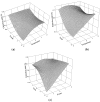Optimization of high-pressure ultrasonic-assisted simultaneous extraction of six major constituents from Ligusticum chuanxiong rhizome using response surface methodology
- PMID: 24518807
- PMCID: PMC6271119
- DOI: 10.3390/molecules19021887
Optimization of high-pressure ultrasonic-assisted simultaneous extraction of six major constituents from Ligusticum chuanxiong rhizome using response surface methodology
Abstract
High-pressure ultrasound-assisted extraction technology was applied to extract ferulic acid, senkyunolide I, senkyunolide H, senkyunolide A, ligustilide and levistolide A from Ligusticum chuanxiong rhizomes. Seven independent variables, including solvent type, pressure, particle size, liquid-to-solid ratio, extraction temperature, ultrasound power, and extraction time were examined. Response Surface Methodology (RSM) using a Central Composite Design (CCD) was employed to optimize the experimental conditions (extraction temperature, ultrasonic power, and extraction time) on the basis of the results of single factor tests for the extraction of these six major components in L. chuanxiong rhizomes. The experimental data were fitted to a second-order polynomial equation using multiple regression analysis and were also examined using appropriate statistical methods. The best extraction conditions were as follows: extraction solvent: 40% ethanol; pressure: 10 MPa; particle size: 80 mesh; liquid-to-solid ratio: 100:1; extraction temperature: 70 °C; ultrasonic power, 180 W; and extraction time, 74 min.
Conflict of interest statement
The authors declare no conflict of interest.
Figures













Similar articles
-
Optimisation of high-pressure ultrasonic-assisted extraction and antioxidant capacity of polysaccharides from the rhizome of Ligusticum chuanxiong.Int J Biol Macromol. 2015 May;76:80-5. doi: 10.1016/j.ijbiomac.2015.02.031. Epub 2015 Feb 27. Int J Biol Macromol. 2015. PMID: 25732619
-
[Optimization of supercritical fluid extraction of bioactive components in Ligusticum chuanxiong by orthogonal array design].Zhongguo Zhong Yao Za Zhi. 2013 Oct;38(20):3484-8. Zhongguo Zhong Yao Za Zhi. 2013. PMID: 24490558 Chinese.
-
Preparative isolation and purification of senkyunolide-I, senkyunolide-H and ferulic acid from Rhizoma Chuanxiong using counter-current chromatography.J Sep Sci. 2011 Dec;34(23):3426-32. doi: 10.1002/jssc.201100547. Epub 2011 Nov 3. J Sep Sci. 2011. PMID: 22052814
-
Volatile component interaction effects on compatibility of Cyperi Rhizoma and Angelicae Sinensis Radix or Chuanxiong Rhizoma by UPLC-MS/MS and response surface analysis.J Pharm Biomed Anal. 2018 Oct 25;160:135-143. doi: 10.1016/j.jpba.2018.07.060. Epub 2018 Jul 31. J Pharm Biomed Anal. 2018. PMID: 30086506
-
Total alkaloids from the rhizomes of Ligusticum striatum: a review of chemical analysis and pharmacological activities.Nat Prod Res. 2022 Jul;36(13):3489-3506. doi: 10.1080/14786419.2020.1830398. Epub 2020 Oct 9. Nat Prod Res. 2022. PMID: 33034219 Review.
Cited by
-
Recent progress on the traditional Chinese medicines that regulate the blood.J Food Drug Anal. 2016 Apr;24(2):221-238. doi: 10.1016/j.jfda.2015.10.009. Epub 2016 Jan 5. J Food Drug Anal. 2016. PMID: 28911575 Free PMC article. Review.
-
An effective vacuum assisted extraction method for the optimization of labdane diterpenoids from Andrographis paniculata by response surface methodology.Molecules. 2014 Dec 31;20(1):430-45. doi: 10.3390/molecules20010430. Molecules. 2014. PMID: 25558855 Free PMC article.
-
Ionic Liquid Solutions as a Green Tool for the Extraction and Isolation of Natural Products.Molecules. 2018 Jul 18;23(7):1765. doi: 10.3390/molecules23071765. Molecules. 2018. PMID: 30021998 Free PMC article. Review.
-
Optimization of Ultrasound-Assisted Extraction Using Response Surface Methodology for Simultaneous Quantitation of Six Flavonoids in Flos Sophorae Immaturus and Antioxidant Activity.Molecules. 2020 Apr 12;25(8):1767. doi: 10.3390/molecules25081767. Molecules. 2020. PMID: 32290627 Free PMC article.
-
Effect analysis of mineral salt concentrations on nosiheptide production by Streptomyces actuosus Z-10 using response surface methodology.Molecules. 2014 Sep 26;19(10):15507-20. doi: 10.3390/molecules191015507. Molecules. 2014. PMID: 25264834 Free PMC article.
References
-
- Chinese Pharmacopoeia Committee . Chinese Pharmacopoeia. Chemical Industry Press; Beijing, China: 2010. p. 38. Part 1.
-
- Tang Y., Zhu M., Yu S., Hua Y., Duan J.A., Su S., Zhang X., Lu Y., Ding A. Identification and comparative quantification of bio-active phthalides in essential oils from si-wu-tang, fo-shou-san, radix angelica and rhizoma chuanxiong. Molecules. 2010;15:341–351. doi: 10.3390/molecules15010341. - DOI - PMC - PubMed
MeSH terms
Substances
LinkOut - more resources
Full Text Sources
Other Literature Sources

